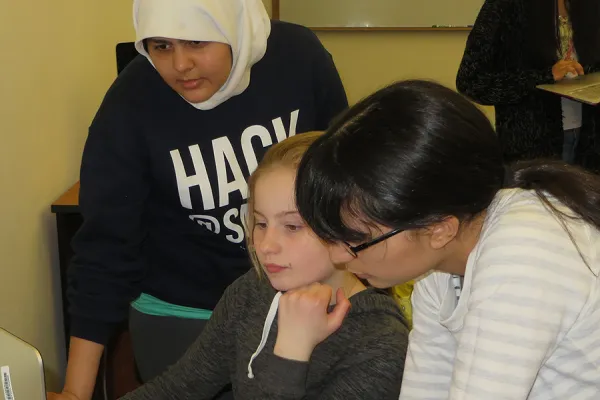Sharing STEM Skills: Students Create Club for Girls Who Code
Campus Life

Published March 30, 2016
Every Wednesday for the past two months, a group of middle and high school girls has been gathering in Bass Hall with a team of Smithies to learn more about computer programming.
A dozen core members of Smith’s new Girls Who Code program are providing the younger girls with a 40-hour curriculum designed to teach computer science skills, including programming, web development and design. The Smith student instructors are backed by a national Girls Who Code organization with curriculum plans, project ideas and teacher support. There is no cost to program participants.
Smith’s Girls Who Code club began last year when a group of Smith students interested in sharing their passion for coding approached Tom Gralinski, Smith’s science outreach coordinator. Led by Zainab Aqdas Rizvi ’18, the students worked through the process of registering a campus club with the national Girls Who Code organization.
They also found student instructors and a faculty adviser for the program, set up a campus computer lab, completed required child safety certifications, and advertised in local schools.
The club launched in February with about 16 girls in grades 6 to 12. In addition to Gralinksi, the team of Smithies received support from computer science professor Nicholas Howe; Tony Caldanaro, program director in Computing & Technical Services for the Clark Science Center; and Tamra Bates, Smith’s director of student engagement.
Rizvi says she was motivated to organize a Girls who Code chapter because “I feel strongly that there needs to be more diversity in computer science.” She says she lacked opportunities or support when she was younger to try coding and wanted to do something to change that.
Khadidja Fares ’19, who volunteers regularly with Smith’s Girls Who Code, says she comes every week to work with the girls because “it is programs like Girls Who Code that motivate young girls to go into a STEM field and encourage them to see the different types of opportunities in STEM.”
Fares says teaching computer skills to girls has also benefited her own education. “I’ve learned that not everyone has the same approach when it comes to a certain problem,” she says. “Every student has a different personality and way of learning. This helped me with being more patient.”
Sharon Vizcaino De La Garza ’17 says “seeing the girls go from knowing no coding at all to being able to create a project on their own is an amazing experience.”
Chapter members say the girls have enjoyed creating animations and other art through coding. Although some participants were initially worried that learning coding was going to be difficult, their hesitation soon disappeared.
The absence of grades helps keep the stress level low, student leaders say, and the collaborative nature of the classroom activities makes working through coding problems fun.
Contributed by Thomas Gralinski, science outreach coordinator, Center for Community Collaboration.
Girls Who Code members Zainab Aqdas Rizvi ’18 (left) and Sharon Vizcaino De La Garza ’17 (right) work with a middle school student on a coding problem.